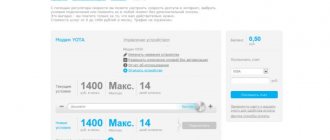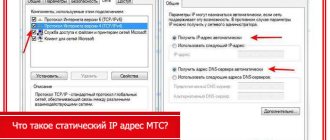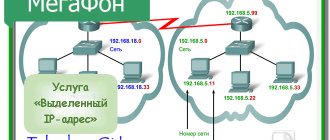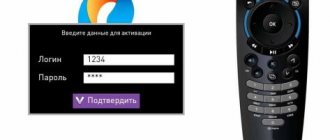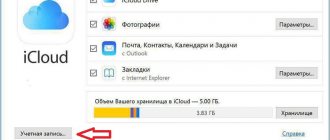The difference between “statics” and “dynamics”
Before you learn how a static IP differs from a dynamic one, you need to understand the principle of its formation. In 1981, the fourth version of the Internet Protocol - IPv4 - was introduced. It began to be used everywhere, for all computers.
The protocol uses a 32-bit binary number divided into 4 bytes or octets to specify an address. Therefore, there can be a total of 2 to the thirty-second power, which is approximately equal to: 4,294,967,296 numbers or IP addresses. Writing identifiers in binary was inconvenient, and they were converted to decimal places.
Each computer on the network was assigned a fixed unique number, and it did not change over time. At first it seemed that more than 4 billion static IP addresses would be enough for all network participants. But by the end of the 80s of the 20th century it became clear that the limit would soon be exhausted.
Now we can explain what dynamic IP addresses are. Most users are not online 24/7 and their static reserved IDs are not used. It was proposed that during the client’s absence, his unique number should be assigned to an active member of the network, and a new one assigned to him at the next contact.
The network user no longer received permanent IP addresses, but dynamic ones - changing with each connection. This made it possible to optimize the distribution of identifiers. It turns out that one “IP address” can connect several users at different times. The DHCP protocol was developed, which automatically assigned addresses to clients for a certain time.
Setting up services
Setting up a static IP
To set up a static IP, you need to reconfigure your equipment (phone or modem) to work with . To do this, in the device control program you need to find the connection settings and change the access point name from “APN” to “ FixedIP. nw", and leave the rest of the settings unchanged.
You can find out your IP address with an active Internet connection in the modem or phone settings, or in the Megafon subscriber department, or in the contact center by number 8-800-550-05-00.
"White" and "gray" identifiers
Static and dynamic IP addresses have one more characteristic. They can be internal or external. Also, internal identifiers can be called “local”, “gray”, “private”, and external identifiers can be called “global”, “white”, “public”.
“White” numbers – have direct access to the Internet without a router or router. They can both send and receive data from any computer on the network. A small fee is charged for an external IP address. Having a public number is required in the following cases:
- The computer is used as a server in online games or a host.
- You need remote access to a PC or video surveillance system.
- Download information from servers without queueing.
- Cannot "bypass" router or router.
“Gray” identifiers cannot be used on the Internet. They are used in local networks that do not have direct access to the global network. They are distributed free of charge by your ISP or router. The following ranges are allocated for them:
- From 10.0.0.0 to 10.255.255.255;
- From 172.16.0.0 to 172.31.255.255;
- From 192.168.0.0 to 192.168.255.255;
- From 100.64.0.0 to 100.127.255.255.
All routers organize a local network that unites computers with internal identifiers. The router has one or more external addresses through which it connects to the Internet. These are called WAN ports. Local devices connect to the global network via NAT technology. It sends requests from “grey” numbers and receives responses from outside.
The advantages of internal IDs include security and free use. It is impossible to carry out a virus attack on a local number from outside; it is under the “protection” of the router. But it cannot be used for a server, since it is not capable of responding to requests from the Internet.
How to get a static IP address in Rostelecom
How to connect a static IP to the Rostelecom provider network? Firstly, you can immediately conclude an agreement for the Internet at a dedicated address. In this case, your personal network “registration” will be indicated in the contract with the provider. In some cases, after this the Internet starts working immediately, in others you may need to slightly reconfigure the connection settings in your operating system.
If you are already using a different type of connection, then you need to go to your Personal Account on the provider’s official website. Next, follow the following algorithm:
- Open the panel of available services at the top of the site.
- Select Fixed IP.
- Make sure that there are funds on your balance at the moment and that they are enough to work during the day.
Note: in this case, the external IP will be assigned to the device through which the network is accessed. If you have a gateway, i.e. a router or router, it will not be possible to obtain a white range address separately for the computer. All elements of the home network will communicate with the Internet through “gray” addresses.
You can also order a fixed IP service by calling the toll-free customer support number 8-800-707-12-12.
The user's further actions depend on the equipment he has. The fact is that on the same network there cannot be devices with two identical IPs, even if one is “white” and the other “gray”. Therefore, if you have a router and several connected computers, you may need to obtain separate addresses for them.
Work on a dedicated IP will begin the next day.
Advantages and Disadvantages of Static Identifiers
The choice between a static or dynamic IP address depends on the purpose of the computer. The advantages of “statics” include:
- More stable connection. A seamless connection is important when authenticating and downloading files. Static IP does not interrupt communication with the server in case of fleeting interruptions.
- If the PC is planned to be used as a host or server, then it needs a static address. If the server has a dynamic IP, then clients will have to verify it each time before connecting.
- Convenient for remote access or using special programs - for example, “TeamViewer”. If you are knocked out of the Internet, then with a dynamic address it will be more difficult to restore access to the desktop.
Along with the advantages, there are also disadvantages:
- Static addresses are more susceptible to hacking. Security measures should be increased when using this identifier.
- Payment is used for the server, then constant presence on the network is paid. The cost may be high.
- Setting up a static “IP address” is more complicated than setting up a “dynamic” one.
Whether a static or dynamic ID is used depends on the tasks being scheduled.
Difference between static and dynamic IP addresses
Dynamic addresses may change. Static ones remain unchanged. Most users who connect to the Internet use a dynamic IP address (that is, one that changes each time they connect to the network). This means that IP addresses can be reused, thus solving the problem of running out of IP addresses.
Differences between static and dynamic IP addresses
However, for businesses that require more advanced Internet functionality, a permanent static IP address is usually required. This is why static IP addresses are not offered as a standard by many internet providers and are usually only provided using premium internet connections.
A static IP address is needed if you:
- are using file sharing software or an HTTP/FTP server. In this case, you will be allocated your own static IP address so that suppliers, clients or anyone else can reliably connect to your server;
- Have your own website or domain name server. In order for a website to respond to requests for its domain name, it must be associated with a static IP address;
- you are using other servers or equipment. Most programs that other companies connect to the Internet are assigned static IP addresses because this makes it easier to connect and test over the Internet.
Examples of situations when you need a static (permanent) IP address
Other examples where a static IP address may be required:
- email or chat servers;
- critical servers such as backup web servers;
- database servers;
- network hardware;
- VPN (virtual private network) that allows people to access applications remotely.
Good to know! Domain names are much easier to set up and use when they point to a static IP address, otherwise you'll have to update your domain's IP address every time you get a new one.
How to determine an IP address
If the connection occurs through a router, then most likely the computer has an internal dynamic identifier. You can find it out like this:
- Go to the OS Windows control panel.
- In the “Network and Internet” section, click on the “View network status and tasks” item.
- In the window that appears, click on the line “Change adapter settings” on the left.
- A menu with network adapters will open. Double-click on the desired one.
- A window will pop up describing the connection. Click on the “Details...” item.
- The last menu will show the IP address of the PC.
To find out the external identifier, you can use a browser. To do this, you need to enter one of the following sites into it: “2IP”, “WhatIsMyIP”, “IP-Ping”, “whoer.net”. After downloading, the identifier with which you connect to the Internet will be shown.
Well, the most important question: how to make a static IP address from a dynamic one? – You can get a permanent external address in two ways: buy from a provider or use special programs, for example, “No-IP”. You can also use the DDNS functionality - read about this in more detail here.
How to connect a static IP?
Before the advent of general computerization in our lives, the connection procedure was much more complicated. Subscribers had to contact the Megafon subscriber department and write a corresponding application. Having carried out certain operations with the subscriber database, the specialist issued one or another address assigned by the system. Now you can do everything yourself.
To connect, call the help desk at 0500 or 8-800-550-05-00 and tell the consultant that you want to connect it.
After clarifying your passport details and the employee performing certain actions, you will be given an address assigned to you, which will be reserved for the entire duration of the contract.
This service is available for connection only to subscribers of St. Petersburg and the Leningrad region, as well as corporate clients.
